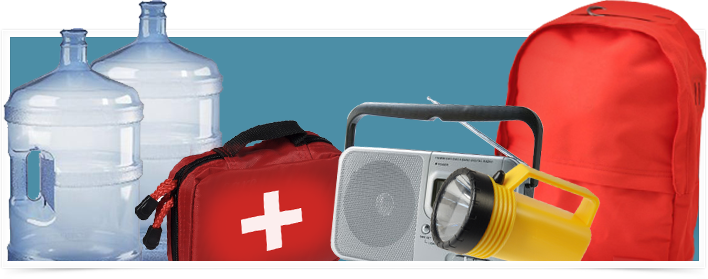
A crucial preparedness activity for everyone is to create a customized family disaster plan and kit. Below are additional considerations for families with access and functional needs:
- NOAA Weather Radios are a valuable communication tool for every family as well as the visually impaired. The radios can also be programmed to provide an alert for the hearing impaired. In some cases, if you already have a home security system, you can connect the radio receiver to your existing alerting system, much the same as a door bell, smoke detector or other sensor. More information is available from the National Weather Service on their NWR for Deaf and Hard of Hearing web page. In addition to weather hazards, NOAA Weather Radios provide emergency information for all hazards.
- Establish a Personal Support Network of individuals who will check with you in an emergency to ensure you are O.K. and to give assistance if needed. Identify a minimum of three people at each location where you regularly spend a significant part of your week: job, home, school, volunteer site, etc. This network can consist of friends, roommates, family members, relatives, personal attendants, co-workers and neighbors.
After a disaster, you may need to ask for help to do things you usually would have done independently. Understandably, this may make you feel especially vulnerable. You may need help putting your home back in order, filling out forms, or providing documentation and information to disaster relief agencies. This can add to the stress you may be feeling. A personal support network that knows your needs may anticipate some of them and make your recovery easier and less stressful.
If you employ a personal attendant or use the services of a home health agency or other type of in-home service, discuss with these people a plan for what you will do in case of an emergency.
- Make Emergency and Medical Information Lists that can be used to help communicate your needs with your personal network and others. Include:
- Names and numbers of people in your personal network, and an out-of-town contact person.
- Tips for communicating with you if you have a communication disability.
- Your medical providers' names and phone numbers.
- Names of medications you take, allergies and sensitivities, the condition for which you take a medication, dosages, when you take it, who prescribed it, and your doctor's phone number.
- Adaptive equipment you use. Label your equipment and attach instruction cards on how to use and move each item.
- Health insurance information and a copy of your most recent Social Security award letter.
- Talk with your doctor or pharmacist about what you should do if you do not have enough medicine after a disaster and cannot immediately get what you need. Be sure you ask about the shelf life of your medications and the temperatures at which they should be stored. Determine how often you should replace stored medication. This helps ensure that a medicines effectiveness does not weaken because of long storage time.
- Add disability-related supplies to your basic disaster supplies kit:
- Scooter or wheelchair patch kit, extra inner tubes, and can of seal-in-air product. Heavy gloves for wheeling over debris and glass.
- Spare battery for your motorized scooter or wheelchair and/or a lightweight manual wheelchair for backup. Ask your vendor about charging and converter options.
- Extra white cane, magnifiers, and glasses.
- Pads and pencils for communication and/or to keep track of instructions you may receive.
- Power converter for communicating with a laptop computer.
- Copies of a word or letter board and preprinted key phrases.
- Pets and service animal supplies (below).
- Pets and Service Animals who assist people with disabilities are the only animals allowed in Red Cross shelters. Effective March 15, 2011, a service animal is defined as .any dog that is individually trained to work or perform tasks for the benefit of an individual with a disability, including a physical, sensory, psychiatric, intellectual, or other mental disability. Other species of animals, whether wild or domestic, trained or untrained, are not service animals for the purposes of this definition. Have a care plan for your service animal and assemble a portable Pet Disaster Supplies Kit. Keep essential supplies in an accessible place and store them in sturdy containers that can be carried easily. Your pet disaster supplies kit should include:
- Medications and medical records (stored in a waterproof container) and a first aid kit.
- Sturdy leashes, harnesses, and/or carriers to transport pets safely.
- Current photo of your service animal in case they get lost.
- Food, potable water, bowls, cat litter/pan, and can opener.
- Information on feeding schedules, medical conditions, behavior problems, and the name and number of your veterinarian in case you have to foster or board your pets.
- Pet beds and toys, if easily transportable.
- Discuss with your power-dependent equipment vendor, fire department, electrician, and/or utility company about safe backup sources of power for your home. Some generators can be connected to the existing wiring systems of a house. Others run on fuel, which need to be properly stored. Generators should be operated outdoors for adequate ventilation.
For oxygen users, check with your provider to determine whether a reduced flow rate may be used in the event of a disaster to prolong the life of the system. Record on your equipment the reduced flow' numbers so that you can easily refer to them.



